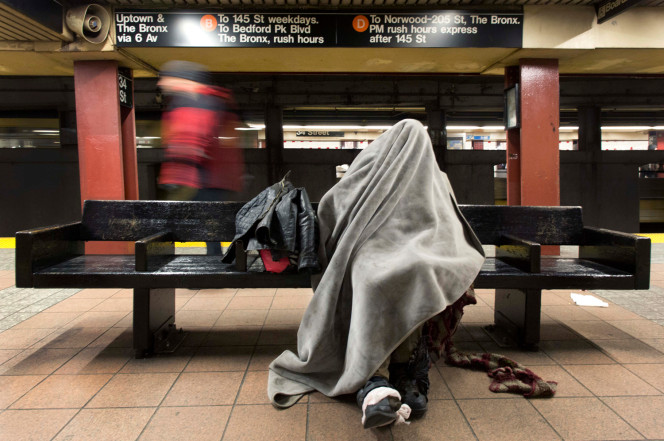 The de Blasio Administration announced today that it is entering the second phase of the City’s plan to convert more cluster buildings into permanent housing for homeless New Yorkers from Harlem to Hollis. Through this preservation transaction, the City will help not-for-profit housing developers acquire and rehabilitate another 14 residential “cluster site” buildings, currently used to house homeless families, and convert them into over 200 permanent affordable housing units to continue addressing the homelessness crisis.
The de Blasio Administration announced today that it is entering the second phase of the City’s plan to convert more cluster buildings into permanent housing for homeless New Yorkers from Harlem to Hollis. Through this preservation transaction, the City will help not-for-profit housing developers acquire and rehabilitate another 14 residential “cluster site” buildings, currently used to house homeless families, and convert them into over 200 permanent affordable housing units to continue addressing the homelessness crisis.
As a result, more than 200 homeless families will receive permanent affordable housing with rent-stabilized leases, regulatory protections, and rehabilitated apartments. When this transaction is complete, this Administration will have reduced city-wide cluster use by nearly 70 percent citywide.
“We’re making good on our promise to transform the shelter system and create more, high-quality permanent housing for New Yorkers in need. With these conversions, over 200 families will have homes of their own, setting them on a path to lasting stability for generations to come,” said Mayor Bill de Blasio.
Earlier this year, in the first completed conversion, the City financed not-for-profit developers’ acquisition of 17 such buildings, creating permanent affordable housing for more than 450 homeless families and preserving hundreds of additional units of affordable housing in the process. This second conversion of 14 buildings to create permanent affordable housing for more than 200 homeless families takes the City’s progress phasing out the 19-year-old Giuliani-era cluster program even further.
Connecting Homeless Families to Permanent Housing––Through this transaction, qualified locally-based not-for-profit housing developers will assume ownership and operation of the buildings as permanent, low-income affordable housing. Regulatory protections will be extended to the converted units to preserve their affordability for the long term, and the buildings will also undergo rehabilitation and renovation. As this transition takes place over the coming months, the cluster apartments will continue to be operated as shelter for New Yorkers experiencing homelessness with funding and services provided by the City’s Department of Homeless Services. Beginning this week, the City will directly engage the families experiencing homelessness and currently residing in these cluster shelter units, going door-to-door and family by family, to discuss this transition and rehousing opportunity with each household, including to verify that families would like to remain at these locations and obtain permanent housing there. Homeless families residing at these locations who are prepared for housing permanency at the point of transition to not-for-profit ownership will be offered the opportunity to remain as tenants with a new rent-stabilized lease if they wish to remain in the building. For families that may be seeking, already connected to, or in the process of preparing to move to permanent housing elsewhere or for families who may have additional service needs (such as mental health services) that require more significant continued support as they get back on their feet will transition to alternative shelter locations before moving to permanency.
Ending the Stop-Gap Cluster Shelter Program Once and For All–– Since January 2016 when the City was using a high-point of approximately 3,600 cluster units and first announced its intention to end the cluster site program, the City’s Department of Homeless Services has reduced the citywide use of cluster apartments to shelter homeless families by more than 60 percent using multiple strategies, including through outright closure, transition to alternative uses, and conversion to permanent housing. This transaction accounts for approximately 16 percent of the remaining cluster units (224 units). When complete, there will be fewer than 1,200 cluster units remaining (approx. 1,175 units), a 67-percent reduction from the high-point.
ICYMI: Turning the Tide on Homelessness in NYC–– The de Blasio Administration has taken aggressive action to address the citywide challenge of homelessness over the past several years, restoring the City’s rental assistance and rehousing programs, which have helped more than 125,000 New Yorkers remain in or secure permanent housing, and directing unprecedented resources toward a new comprehensive and holistic approach to fighting homelessness focused on prevention, street homeless outreach, expanded transitional housing options, averted shelter entry, improved shelter conditions, expanded civil legal services, and more robust rehousing and aftercare services. In February 2017, the Mayor announced ‘Turning the Tide on Homelessness in New York City,’ his neighborhood by neighborhood blueprint for transforming a shelter system that built up in a haphazard way over decades. The plan has four core pillars:
- Preventing homelessness whenever we can;
- Addressing street homelessness;
- Rehousing families and individuals so they can move out of shelter or avoid homelessness altogether; and
Transforming the haphazard approach to providing shelter and services that has built up over the last four decades by shrinking the Department of Homeless Services’ footprint by 45 percent and ending the use of 360 “cluster” shelter and commercial hotel locations while opening a smaller number of 90 borough-based shelters in all five boroughs
2019 Status Update: Headed in the Right Direction, More Work to Do–– The de Blasio Administration’s strategies have taken hold, headed in the right direction. The shelter census for 2017 and 2018 remained essentially flat year over year for two years for the first time in more than a decade; and through the strategies outlined above and below, the City is preventing homelessness, providing permanent housing, shrinking and strengthening the NYC DHS shelter footprint and raising the bar for the services and supports provided citywide. Moving aggressively to implement each pillar, the City has made important progress:
Investing in legal services and implementing first-in-the-nation access to counsel plan for tenants in housing court: evictions dropped by approximately a third between 2013 and 2018
Investing in comprehensive HOME-STAT outreach and specialized Safe Haven shelter for street homeless individuals: tripled the number of dedicated ‘safe haven’ beds citywide, with hundreds opening in the coming years, and helped more than 2,200 homeless New Yorkers off the streets and subways who’ve remained off
Rebuilt rental assistance from scratch after City and State cuts in 2011 and reinstated rehousing programs: helped more than 125,000 children and adults remain in or secure permanent housing, with the vast majority exiting shelter to permanent housing
Closing less effective stop-gap shelters while opening new high-quality borough-based shelter sites: closed more than 200 shelter sites that did not meet our standards (down from the 647 sites reported in Turning the Tide) and sited 55 new borough-based shelters, shrinking the DHS shelter footprint by a third (31%)—well on the way towards the goal of shrinking the footprint by 45 percent overall.
“Today marks the next step in a transition that promises to uplift hundreds of more families in New York City, as we continue to convert cluster sites into permanent affordable housing urgently needed in our communities,” said Deputy Mayor for Health and Human Services Dr. Raul Perea-Henze. “Through the use of this innovative tool in partnership with local non-profit housing professionals who can support our families with services as needed, we continue to place homeless New Yorkers on the path to long-term stability and move closer to ending the ineffective stop-gap measure of cluster sites once and for all.”
“Earlier this year, we provided permanent housing to more than 1,000 New Yorkers in need when we helped experienced, locally-based affordable housing developers acquire a portfolio of cluster buildings in their entirety—the first of a series of bold transactions to both address homelessness and end the Giuliani-era cluster program,” said Department of Social Services Commissioner Steven Banks. “Today, we are announcing the second use of this proven strategy to connect several hundred more homeless families to preserved affordable housing for the long-term. As part of this next phase, we are ending the use of another 14 cluster locations as shelter and transferring ownership to non-profit housing developers who will upgrade these buildings and provide more than 200 families with upgraded apartments, rent-stabilized leases, and regulatory protections for generations to come.”
“The de Blasio Administration continues to work collaboratively to implement holistic efforts to address the homelessness crisis,” said New York City Department of Housing Preservation and Development (HPD) Commissioner Louise Carroll. “I am proud of the hard work and dedication displayed by all parties in this agreement to convert these apartments into permanent, affordable housing for our most vulnerable New Yorkers.”
“I’m glad that the Mayor and Commissioner Banks are moving forward with eliminating the very problematic approach of using so-called cluster sites as a temporary shelter, and emphasizing permanent housing,” said State Senator Brian Kavanagh, Chair of the Senate Housing Committee. “I look forward to working with the Mayor, the Commissioner, and our colleagues in city and state government to provide more resources and better solutions to end homelessness in New York City and throughout the state.”
“Securing permanent, affordable housing for our most vulnerable residents has been a priority that we’ve worked hard to address on the city and state levels of government, and I’m pleased that we’re pursuing creative solutions that have allowed us to make significant progress toward this goal,” said Assembly Member Steven Cymbrowitz, Chair of the Assembly’s Housing Committee. “The conversion of these additional units will represent hope, stability and a future for so many families in our city, and that’s an exciting
“The Bronx is suffering from the homeslessness crisis, and has been hit hard over the past decades from the failures of cluster sites, said Senator Luis Sepulveda. “I commend Mayor de Blasio on his efforts to close all cluster sites by 2021, in our city-wide efforts to combat the causes and consequences of homelessness and ensure reliable, quality, and affordable housing for all.”
“The shamefully mismanaged ‘cluster site’ housing program has failed to live up to its promises, providing substandard housing for some of New York’s most vulnerable for too long. To address New York’s homelessness crisis we need safe, long term solutions that promote stability and treat people with dignity,” said Assembly Member Al Taylor. “Shuttering and converting these cluster sites is long overdue and I welcome any opportunity to create affordable housing and keep families together and off the streets.”
“This effort means more affordable housing for New Yorkers who need it the most,” said NYC Council Finance Chair Daniel Dromm. “By helping local non-profit housing developers acquire a majority of remaining cluster sites, the City is taking steps to end a Giuliani-era stop-gap measure and increase permanent housing for low-income families. I applaud Mayor de Blasio and Commissioner Banks for leading this important effort which has long been a priority for housing activists.”
“Mayor de Blasio is moving New York City closer to the applaudable goal of closing cluster shelters,” said Mitchell Netburn, President & CEO of Samaritan Daytop Village. “As one of the agencies chosen to redevelop and provide social services at a Phase 1 site, we are seeing, firsthand, that giving formerly homeless families stable, safe, supportive and affordable housing can make a dramatic and positive difference in their lives. Samaritan Daytop Village is proud to partner with the Mayor, once again, to transform these Acquisition Phase 2 sites and help turn the tide on homelessness.”
“MHANY Management Inc. is proud to be a partner as the City takes bold and necessary steps towards ending the scatter site shelter program by providing formerly homeless individuals and families a place they can truly and safely call home,” said Ismene Speliotis, Executive Director of MHANY Management Inc.
“Converting these apartments from cluster sites into permanent, affordable housing for homeless New Yorkers is the right move, and will provide much-needed housing to homeless families. The City is making good on its pledge to reduce the use of problematic cluster site shelters, and this announcement expands the supply of housing available and affordable to those without homes — an important piece of the puzzle in the larger fight to reduce record homelessness,” said Giselle Routhier, Policy Director at Coalition for the Homeless.
“Homeless Services United commends the de Blasio administration on another successful conversion of cluster shelter to permanent, affordable housing,” said Catherine Trapani, Executive Director of Homeless Services United. “Thanks to this extraordinary effort, we are not only moving closer to the goal of closing ineffective, costly shelter models but, two hundred families will have their very own rent-stabilized apartments in buildings owned and operated by responsible nonprofits with a commitment to quality housing that is affordable in the long term. Congratulations to all involved in this important effort.”
Photo credit: By Rudy Collins.
Become a Harlem Insider!
By submitting this form, you are consenting to receive marketing emails from: . You can revoke your consent to receive emails at any time by using the SafeUnsubscribe® link, found at the bottom of every email. Emails are serviced by Constant Contact








